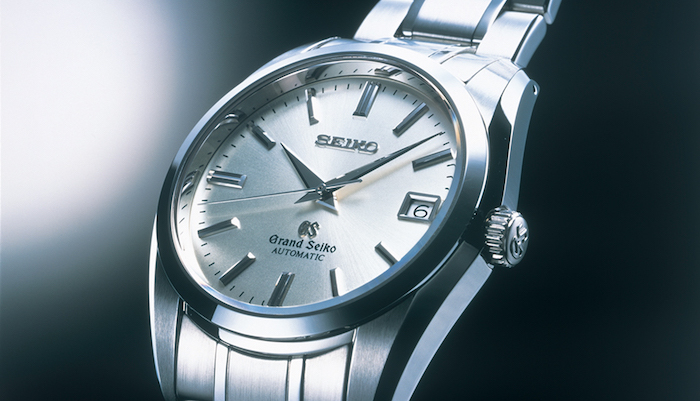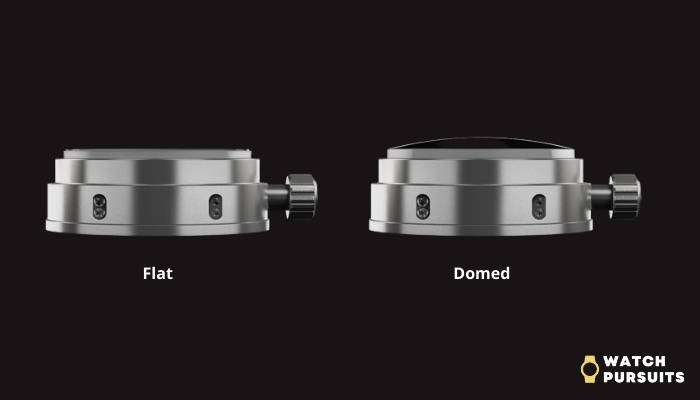When it comes to watches, the crystal is one of the most critical parts. There are many different crystals, each with its own advantages and disadvantages. This blog post will discuss the different types of watch crystals and help you choose the right one for your watch!

What Is A Watch Crystal?
Watch crystals are the transparent coverings that protect watch faces.
A good watch crystal is designed to protect the watch from the elements yet allow maximum visibility to you to read the watch.
Watch crystals are not actual crystals but made of various manufactured crystalline glass-like materials.
What Types Of Watch Crystals Are There?
There are three main types of watch crystals: acrylic, mineral glass, and sapphire.
Acrylic Crystals
Acrylic crystals are the most common type of crystal used in watches. It is a type of clear plastic.
You might also see variants of acrylic crystals such as Hesalite, Plexiglass when shopping for watches.
Acrylic crystals are lightweight and shatter-resistant, making them ideal for everyday wear. They can also be polished to create a new clean surface if scratched.
Watchmakers also like acrylic crystals for their flexibility – they can easily bend the crystal to create beautiful shapes.
However, they are not as scratch-resistant as other crystals and can become cloudy over time.
At times, premium watches will use acrylic crystals for better performance. For example, certain dive watches use acrylic crystals to handle underwater pressure better.
Omega Speedmaster Moonwatch also uses a type of acrylic crystal called Hesalite crystal, as it is more shatter resistant than other crystals.
Mineral Crystals
Mineral crystals are a type of hardened glass used in many watches.
It is made from natural or artificial minerals such as Silica. It has a higher scratch resistance compared to Acrylic crystals.
Mineral crystals are usually seen in entry-level watches due to the lower cost. They also give a better appearance than acrylic crystal, as it does not look ‘plasticky’ and ‘cheap.’
However, it is not as shatter-resistant as acrylic crystals and can chip or break if dropped.
Sapphire Crystals
Sapphire is the most durable type of crystal used in watches. It is made from crystallized corundum, a form of aluminum oxide.
You see sapphire crystals in more premium and luxury watches.
Sapphires are highly scratch-resistant, as it is a rigid material.
You measure how hard a mineral is in Moh scale. 1 is softest, and 10 the hardest.
Sapphire is at 9 Mohs, with the diamond at 10.
This means it is almost impossible to scratch a sapphire crystal unless you use a diamond.
Sapphire crystals are not the same as sapphire gemstones. It is a synthetic version, made with a transparent version of aluminum oxide.
Sapphire crystals, however, are more prone to shatter, particularly if exposed to impact with a focused point.
| Acrylic | Mineral | Sapphire | |
| Price | Low | Medium | High |
| Shatter Resistance | High | Medium | Medium-Low |
| Scratch Resistance | Low | Medium | High |
| Reflectiveness | Low | Low | High |
Are There Other Types of Watch Crystals?
There have been efforts to improve watch crystals to increase the hardness and scratch resistance and keep the cost down. These are some unique crystals that you might have seen or heard elsewhere:
Mineral Crystal With Sapphire Coating
Popular with microbrands, this crystal involves placing a layer of sapphire crystal on top of a mineral crystal.
This lowers the cost per crystal and still provides stronger scratch resistance. Seiko has used this method before, and they called their crystals Sapplex.
The downside of this method is that the layers might separate after some time. That means extra effort to go to a watchmaker to fix the issue.
Seiko Hardlex

Hardlex is Seiko’s proprietary mineral glass hardening technology. Hardlex crystals are more scratch-resistant than usual mineral glass and are more shatter-resistant.
Seiko uses additional materials such as Boron in the production of Hardlex crystal. Boron is a hard mineral with 9.5 Mohs in hardness; therefore, adding Boron into the crystal further strengthens it.
I generally see Hardlex as a solid and great crystal between mineral and sapphire.
Stührling Krysterna
Krysterna is Stührling’s proprietary mineral crystal, which they claim to be more shatter-resistant than Sapphire crystal.
Stührling released some information about the production of Krysterna crystals, using the Verneuil process to heat up Aluminium Oxide into droplets, and allowing it to harden.
The process described does not sound any different than the typical production of watch crystals; therefore, I see Krysterna as probably more a marketing gimmick than anything.
It doesn’t help that their claim to be more shatter resistant than sapphire crystal is already achieved by a mineral glass on its own.
Plus, Krysterna crystals have a mixed review in the market as well.
Therefore I never took their claims seriously and only treated a Krysterna crystal similar to another mineral crystal.
Are There Additional Upgrades To A Watch Crystal?
Some crystals do have additional treatments to improve performance, such as a layer of AR (Anti-Reflecting) coating and color tint.
AR (Anti-Reflective Coating)
AR coating is added to watch crystals to reduce glare and reflection, especially when viewed from an angle or under direct sunlight.
Sapphire crystals are very prone to reflecting light; therefore, AR coating is more likely to apply them.
However, AR coating is prone to scratching, which causes people to think that the sapphire crystal has scratched.
Color Tint

At times color tints are added to the watch crystal to enhance clarity. This is achieved by adding blue or green tint hues, often together with the AR coating.
How To Tell What Crystal Is A Watch Using?
The best way to do this is by checking on the watch specifications sheet. Often the type of crystal used will be written down.
Check with the company or the salesperson if you see anything different from acrylic, mineral, or sapphire crystals. It could be a variant of any of the three.
To further confirm the use of crystals, you can perform some inspections to check it yourself. These steps might be helpful if you are buying a used watch.
Water Drop Inspection

Drop a drop of water onto the crystal. If the water forms into a bead and stays, it is likely a sapphire crystal. If the water spreads, it is probably a mineral crystal.
Touch Inspection
Touch the watch crystal and feel the sensation. It is likely a sapphire crystal if the crystal is cool to the touch. If it doesn’t feel cool, it could be a mineral crystal.
Use a Crystal Tester
To be absolutely sure, you may consider investing in a diamond tester. What this tool does is measure the hardness of the crystal itself.
If it is a sapphire crystal, the hardness should be at 9mohs and above. If it is lower, it is likely a mineral crystal.
Before performing these tests, it is a good idea to clean the surface of the crystal with a microfiber cloth first, as fingerprints, oil, and dust could affect test results.
Which Crystals Are The Best For Me?
In general, always go for a sapphire crystal. It is the most scratch-resistant of all the crystals here and the most premium-looking.
Although sapphire crystal is prone to shatter, it generally requires a strong and focused force to shatter it. You are very unlikely to cause this unless you are in physical labor. I have personally never broken a sapphire crystal.
If you are getting a watch to wear for outdoor and physical activities and are afraid of shattering your watch crystal, perhaps a mineral crystal might work.
This is because mineral crystals are less prone to shattering than sapphire and yet still strong enough to withstand scratches.
You can also consider Hardlex crystal. But this will limit you to only Seiko watches only.
Wrapping Up
Hopefully, this guide has helped to clear some confusion about the types of watch crystals and that you are more aware of the strength, weaknesses, and which crystals suit your horological needs.
Do you have any experience or issues with watch crystals? Feel free to share in the comment below. Looking forward to interacting with you!
Additional Q&A About Watch Crystals
How are watch crystals made?
Watch crystals are made differently, depending on type:
- Acrylic crystals are basically plastic or plexiglass molded into shape.
- Mineral crystals are glass with extra heating applied (tempering) to harden the surface.
- Sapphire crystal is made by melting aluminum oxide into liquid form and solidifying it into crystals.
Can I polish watch crystals?
Only acrylic crystals are easily-polishable. Once polished, the scratches are gone. Mineral crystals are generally unpolishable due to their tempered outside surface. Sapphire crystals do not need polishing as they are tough to scratch unless you use a diamond.
Can I change the crystals on my watch?
You can always change your watch crystals. Get the measurement of your watch crystal, order the crystal, and install it using a watch crystal press. Or you can always visit a watchmaker, and he would be able to do it for you professionally.
Why are some watch crystals in dome shape?

A dome-shaped crystal gives depth when reading the watch, adding a sense of luxury. A domed crystal also has less reflection when viewed from an angle or underwater.
Why does my watch crystal have a blue hue/tint?
This could be due to the AR(Anti-reflecting) coating. The AR coating generally carries a blue tint, although certain watches such as the Rolex Milgauss use a green tint.


